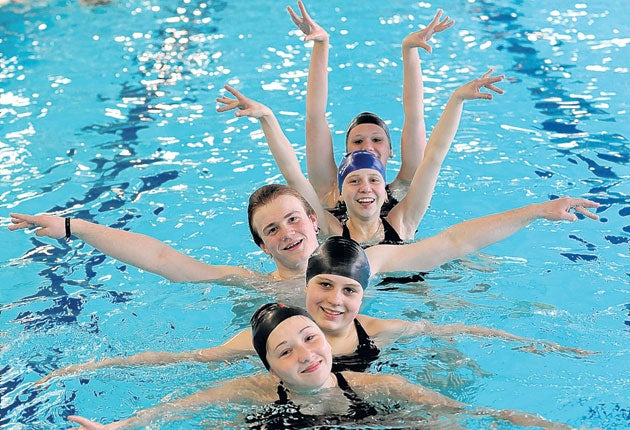The male synchronised swimmer barred from the Olympics
Tony Paterson reports on the male synchronised swimmer fighting for equality

Niklas Stoepel has to shave his legs and wear bathing suits embroidered with sequins in order to take part in his favourite sport.
Yet, despite the derision of schoolmates who call him names, the 17-year-old is one of Germany's leading synchronised swimmers. He has walked away with a string of national trophies in a sport that – to his dismay – is almost completely the preserve of women.
His ambition is to be a member of the German synchronised swimming team when it competes in the 2012 Olympics in London. But although hardly a day has passed in the past decade when he has not been training in a pool, there is little chance of his realising his dream.
For when it comes to international competition, synchronised swimming is a women-only sport. The Federation International de Natation (Fina), the world body which oversees the discipline, refuses to alter what many claim is an extraordinarily backward, if not sexist, attitude to the sport.
"I feel as if I am being discriminated against," Niklas says. "I believe that officials just don't want to see any men taking part in this sport." To combat what he sees as anti-male prejudice, Niklas has gone public in the hope that media exposure will effect change.
The discipline can be traced back to the Romans and ancient Greeks, who began using male swimmers to perform water gymnastics in flooded amphitheatres. The sport resurfaced as "ballet in the water" in the late 19th century, with the first known competition in Berlin in 1891. At the turn of the last century, the participants were mostly male.
Yet soon afterwards, the sport began to take off as an exclusively female activity. One of the highlights was a performance by the Australian Annette Kellerman, pictured, who, in 1907, performed spectacular underwater ballet in a glass tank in New York.
By 1934 the term "synchronised swimming" was being used to describe the water ballet performed by an American all-women team called the Modern Mermaids. Yet it was only in 1984 that the sport was officially admitted to the Olympic Games.
Synchronised swimmers, like Niklas, wear nose clips to keep the water out during underwater somersaults. During competitions, they wear often elaborately decorated swimsuits and perform to the sound of music played to them through loudspeakers above and below the water. Like actors, competitors sometimes wear heavy eye make-up to dramatise their performance.
Like any male ballet dancer, Niklas sees dressing up as the necessary theatrical prop that goes with his sport. He started synchronised swimming at age seven, when his cousin Leona took him along to a training session at his local swimming club in Bochum. Now he trains for up to five hours a day. He says that although he was once laughed at by his schoolmates for taking part, he is now respected for his commitment to the discipline.
In Germany during the national competitions in which he is allowed to compete, the only problem appears to be the judges. "Many of them are stricter when it comes to awarding me points than they are with the female competitors," he said, "It's not fair, but I still haven't given up my dream of one day competing in an international championship."
The last time that the ban received attention was during the Sydney Olympics in 2000 when the American Bill May was barred from taking part although he had fulfilled all the necessary qualifications.
The world's senior swimming officials seem unable to provide a convincing answer as to why the sport is not thrown open to men. An attempt to gain an explanation ended in what looked like bureaucratic buck-passing earlier this week when Ulla Lucenius, the official responsible for synchronised swimming at Fina, said it had not received enough requests from swimming clubs around the world for a rule change to be considered.
The German Swimming Association spokesman Peter Purtz said his organisation would not be pushing for change. "It is not discrimination. It's like ski jumping. For years that was a male-only sport," he said. "You should not be asking us why men are not allowed to take part, you should ask Fina – they make the rules."
Join our commenting forum
Join thought-provoking conversations, follow other Independent readers and see their replies
Comments